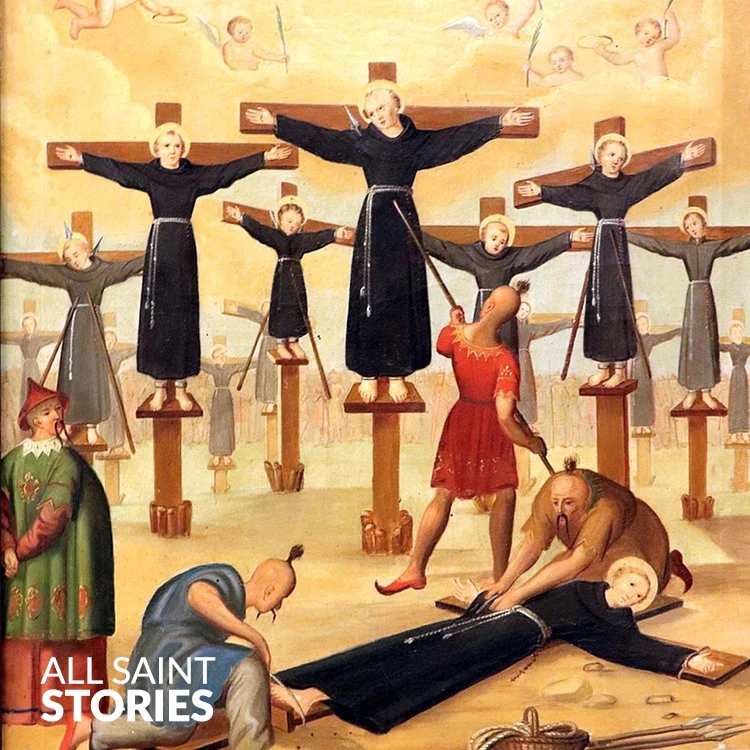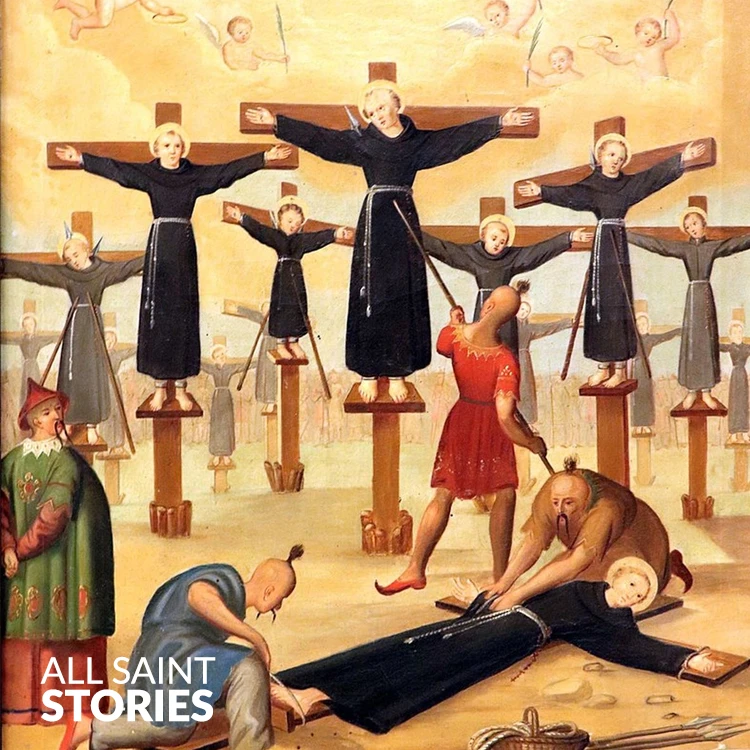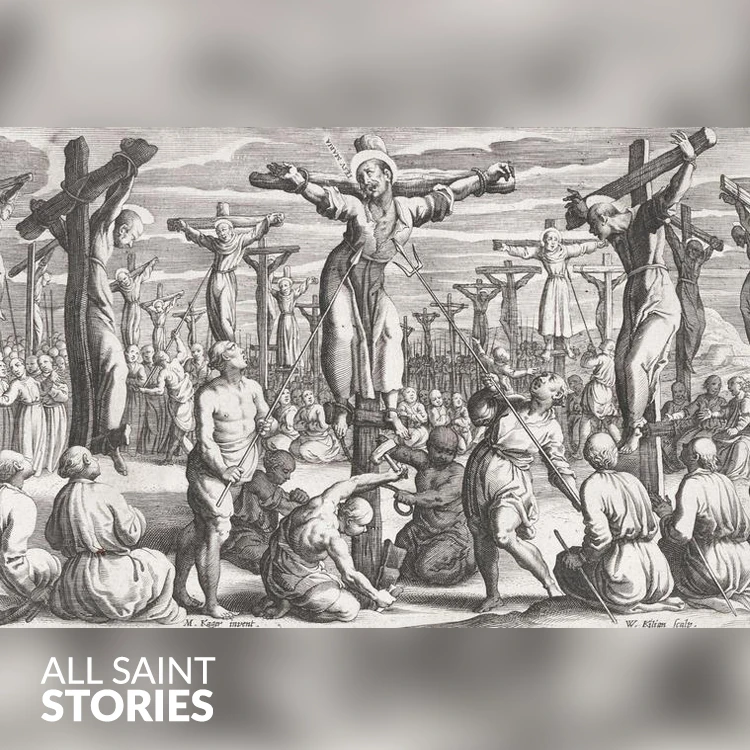Dear Saints, 26 Martyrs of Japan, You gave your lives in faithful witness to Christ, bravely enduring suffering for the sake of His love. We ask for your intercession, that we may have the courage and strength to follow Christ’s example in our own lives. May your example inspire us to live with faith, hope, and love, and may your prayers guide us on our journey to holiness. Help us to remain steadfast in our faith, even in times of trial, and to always trust in God’s mercy and grace. Amen. Through Christ our Lord, Amen.
ST. 26 MARTYRS OF JAPAN
ST. 26 MARTYRS OF JAPAN

The 26 Martyrs of Japan were a group of Catholic missionaries and Japanese converts who were executed by crucifixion in Nagasaki on February 5, 1597, under the orders of Toyotomi Hideyoshi. They are venerated as martyrs and saints by the Catholic Church.
Early Christianity in Japan
The spread of Christianity in Japan began with the arrival of Portuguese Jesuit missionaries in 1549, led by St. Francis Xavier. Initially welcomed by local rulers, including the daimyō Shimazu Takahisa of Kagoshima, the Jesuits were allowed to establish missions in exchange for facilitating trade with Europe. Over the next several decades, Catholicism grew, particularly in Kyushu, where many local rulers converted and supported the missionaries. However, by the late 16th century, the shogunate became increasingly wary of foreign influence, especially as Spanish and Portuguese colonial ambitions became evident elsewhere in Asia. Fearing that Christianity could be a tool for colonialism, the ruling elite began to crack down on its spread.
Persecution and Martyrdom
The first major persecution of Christians in Japan occurred under Toyotomi Hideyoshi. In 1597, he ordered the arrest of 26 Catholics, including both foreign missionaries and Japanese converts. They were subjected to brutal treatment, including public humiliation, physical mutilation, and forced marches through various villages as a warning to others. Despite these hardships, they remained steadfast in their faith.
On February 5, 1597, the 26 were crucified on Nishizaka Hill in Nagasaki. Unlike the traditional method of crucifixion, where victims would be left to die slowly, these martyrs were also pierced with lances to ensure a swift death. Among them was Paul Miki, who preached to the gathered crowd even as he was dying, declaring his faith in Christ and forgiving his persecutors. His final words, along with the unwavering faith of his fellow martyrs, left a deep impression on those who witnessed the execution.
The Aftermath of the Persecution
The martyrdom of the 26 was only the beginning of a larger persecution. Between 1597 and 1614, approximately 70 more Christians were martyred. In 1614, Christianity was officially outlawed, and underground communities of "hidden Christians" (Kakure Kirishitan) developed, preserving their faith in secret for over two centuries. In 1632, the Great Genna Martyrdom resulted in the execution of 55 more Catholics in Nagasaki, further cementing Japan’s suppression of Christianity.
For nearly 250 years, the Church in Japan existed without clergy, relying on oral traditions and secret gatherings. When Western missionaries returned to Japan in the 19th century, they were astonished to find thousands of Christians still practicing their faith in secrecy.
Recognition and Canonization
The 26 Martyrs of Japan were beatified on September 14, 1627, by Pope Urban VIII. Over two centuries later, they were canonized by Pope Pius IX on June 8, 1862. Their feast day was set on February 6, the day following their martyrdom, as February 5 is traditionally reserved for the feast of St. Agatha.
Their legacy has been honored worldwide. The Twenty-Six Martyrs Museum and Monument in Nagasaki stands as a testament to their sacrifice. Additionally, the Church of the Holy Japanese Martyrs in Civitavecchia, Italy, is dedicated to them, and their story continues to inspire Catholics and Christians across denominations. In 1959, the Anglican Church in Japan added them to its calendar, and the Evangelical Lutheran Church in America followed suit in 2005.
Today, the 26 Martyrs of Japan remain powerful symbols of faith and perseverance in the face of religious persecution. Their story highlights the struggles faced by early Christian communities in Japan and the enduring strength of faith despite immense challenges. Their legacy continues to be celebrated annually on February 6, and their impact on the history of Christianity in Japan remains profound.
Video Not Found
The information on this website is compiled from various trusted sources. While we aim for accuracy, some details may be incomplete or contain discrepancies.
If you notice any errors or have additional information about this saint, please use the form on the left to share your suggestions. Your input helps us improve and maintain reliable content for everyone.
All submissions are reviewed carefully, and your personal details will remain confidential. Thank you for contributing to the accuracy and value of this resource.
Credits & Acknowledgments
- Anudina Visudhar (Malayalam) – Life of Saints for Everyday
by Msgr. Thomas Moothedan, M.A., D.D. - Saint Companions for Each Day
by A. J. M. Mausolfe & J. K. Mausolfe - US Catholic (Faith in Real Life) – Informational articles
- Wikipedia – General reference content and images
- Anastpaul.com – Saint images and reflections
- Pravachaka Sabdam (Malayalam) – Saint-related content and insights
We sincerely thank these authors and platforms for their valuable contributions. If we have unintentionally missed any attribution, please notify us, and we will make the correction promptly.
If you have any suggestion about ST. 26 MARTYRS OF JAPAN
Your suggestion will help improve the information about this saint. Your details will not be disclosed anywhere.
© 2025 Copyright @ www.allsaintstories.com



 English
English
 Italian
Italian
 French
French
 Spanish
Spanish
 Malayalam
Malayalam
 Russian
Russian
 Korean
Korean
 Sinhala
Sinhala
 Japanese
Japanese
 Arabic
Arabic
 Portuguese
Portuguese
 Bantu
Bantu
 Greek
Greek
 German
German
 Dutch
Dutch
 Filipino
Filipino